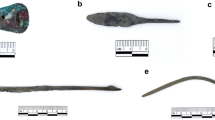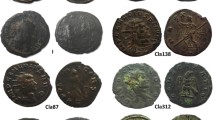Abstract
“Dinheiros” are the first Portuguese coins, minted with a billon alloy (majority-based copper alloyed with silver). In this work, a set of “dinheiros” from D. Fernando of Portugal was analyzed and the composition of the alloy was compared with other “dinheiros” from previous reigns. Although the coins were in good state of conservation and no active corrosion was macroscopically observable, they still presented a corrosion layer of unknown thickness that would impair the XRF quantitative determinations. In order to overcome this hindrance, the silver K/L intensity ratios were determined and compared for the analyzed samples in order to choose “clean” spots for quantitative analysis. The results show a clear decrease in the Ag content: from 7–9 % in the previous reigns to 0.2–0.3 % in the coins attributed to D. Fernando. The silver content determined is very comparable to the silver content determined in other copper or bronze artifacts analyzed, leading us to believe that this low amount of silver was not intentionally introduced to create a billon alloy but relates to impurities present in the original mineral specimen.





Similar content being viewed by others
References
N. Kallithrakas-Kontos, A.A. Katsanos, A. Aravantinos, M. Oeconomides, I. Touratsoglou, Archaeometry 35, 265 (1993)
A. Gomes, Moedas Portuguesas e do Território Português Antes da Fundação da Nacionalidade, 2nd edn. (Trama-artes gráficas Lda, Lisbon, 1996)
M.F. Guerra, J.N. Barrandon, F. Magro, F.B. Gil, Revue d’archéométrie 13, 31 (1989)
A.G. Karydas, Ann. Chim. 97, 419 (2007)
A. Guilherme, A. Cavaco, S. Pessanha, M. Costa, M.L. Carvalho, X Ray Spectrom. 37, 444 (2008)
V. Kantarelou, F.J. Ager, D. Eugenidou, F. Chaves, A. Andreou, E. Kontou, N. Katsikosta, M.A. Respaldiza, P. Serafin, D. Sokaras, C. Zarkadas, K. Polikreti, A.G. Karydas, Spectrochim. Acta, Part B 66, 681 (2011)
A. Pitarch, I. Queralt, Nucl. Instr. Meth. Phys. Res. B 268, 1682 (2010)
D. Šatović, V. Desnica a, S. Fazinić. Spectrochim. Acta, Part B 89, 7 (2013)
J.M.P. Cabral, M.G. Marques, O arqueólogo português 1, 391 (1983)
C.M.B. Martins, J.I. Martins, Prot. Metals Phys. Chem. Surfaces 47, 128 (2011)
A. Denker, W. Bohne, J. Opitz-Coutureau, J. Rauschenberg, J. Rohrich, E. Strub, Nucl. Inst. Meth. Phys. Res. B 239, 65 (2005)
R. Linke, M. Schreiner, Mikrochim. Acta 133, 165 (2000)
A. Kratschmer, I.O. Wallinder, C. Leygraf, Corr. Sci. 44, 425 (2002)
J. Godinho, J. Silveira, A. Mata, M.L. Carvalho, S. Pessanha, Nucl. Inst. Meth. Phys. Res. B 337, 78 (2014)
E. Pernicka, in Metals in antiquity, ed. by A.M. Pollard, P. Budd, R.A. Ixer, S.M.M. Young (Archaeopress, Oxford, 1999)
L. Robbiola, J. Blengino, C. Fiaud, Corr. Sci. 39, 2083 (1998)
M.G. Marques, Tip (António Coelho Dias, Lisboa, 1978)
Acknowledgments
This investigation was funded by Fundação para a Ciência e Tecnologia (FCT) with the project Pest-OE/FIS/UI0303/2014. S. Pessanha would like to thank FCT for the postdoc Grant SFRH/BPD/94234/2013. M. E. M. Jorge would like thank project Pest-OE/QUI/UI0612/2013 for the funding. Authors would like to thank Prof. Mª Fátima Araújo, from Instituto Tecnológico e Nuclear, for providing the reference alloys and Ricardo Moreno for photographing the coins.
Author information
Authors and Affiliations
Corresponding author
Rights and permissions
About this article
Cite this article
Pessanha, S., Costa, M., Oliveira, M.I. et al. Nondestructive analysis of Portuguese “dinheiros” using XRF: overcoming patina constraints. Appl. Phys. A 119, 1173–1178 (2015). https://doi.org/10.1007/s00339-015-9087-2
Received:
Accepted:
Published:
Issue Date:
DOI: https://doi.org/10.1007/s00339-015-9087-2




